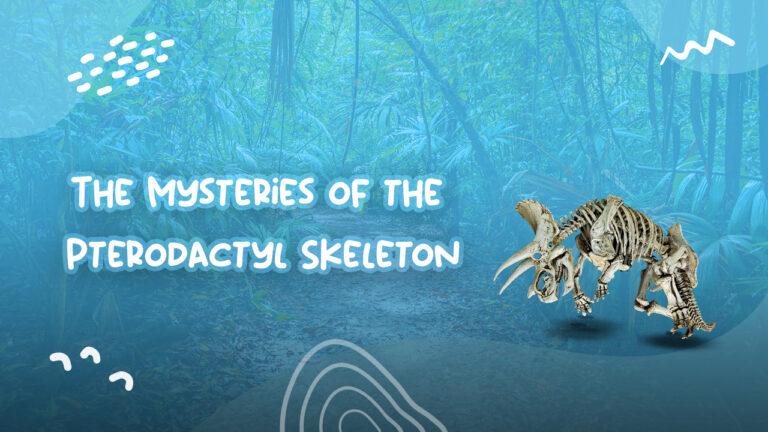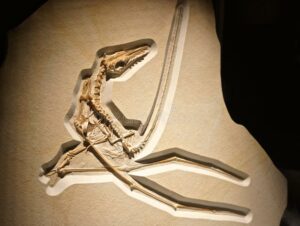The Mysteries of the Pterodactyl Skeleton

Let’s travel back in time, to an era where colossal reptilian creatures ruled the skies, seas, and lands – the Mesozoic Era. Dinosaurs have always captured our imagination, but one group of prehistoric giants stands out above the rest: the pterosaurs, with the pterodactyl taking the spotlight for its iconic appearance. In this blog post, we’ll explore the enigmatic pterodactyl skeleton, discovering its unique anatomy, captivating history, and the scientific strides that have been made in understanding these magnificent creatures.
The History of Pterodactyls
Pterodactyls, belonging to the larger group of pterosaurs, were the first known vertebrates to achieve powered flight. Their anatomy is distinct from that of modern birds and bats, allowing them to conquer the skies in ways unparalleled by other winged creatures. Their skeletal structures, from elongated skulls and dagger-like teeth to their magnificent wingspans, have captivated both scientists and the public alike.
The true standout feature of the pterodactyl skeleton is the elongated fourth finger that supported their membranous wings. Unlike the feathery wings of birds or the finger-collapsible wings of bats, pterodactyls utilized a vast membrane of skin, muscle, and blood vessels called the pterosaur patagium to achieve their stupendous aeronautic feats. This wing structure provided not only incredible maneuverability but also energy-efficient gliding capabilities, courtesy of their lightweight bones composed of thin-walled and hollow structures.
Another distinctive feature of the pterodactyl skeleton is their elongated skull and jaw, which housed an array of sharp, conical teeth adapted for their carnivorous diet. Many pterodactyl skeleton species had pronounced crests atop their skulls, making for an imposing appearance. These crests likely played a role in sexual display or species recognition. The curvature and size of the jaws varied between species, reflecting their preferred prey, such as fish or small terrestrial animals.
The pterodactyl’s unique pelvic structure also warrants appreciation. Their pelvis and legs were adapted for a quadrupedal stance, supported by both their hind limbs and their elongated finger joints. Additionally, their feet were specialized for grasping and climbing, rather than perching like modern birds. This exceptional arrangement allowed pterosaurs to exploit ecological niches that were out of reach for their landlocked dinosaur counterparts.
In recent years, a series of fascinating discoveries have shed light on the true complexity of pterodactyl skeletons. Advanced imaging techniques have unveiled intricate details on their bone structure, paving the way for comprehensive study and understanding of their flight mechanics, growth rates, and lifestyle. Moreover, well-preserved pterodactyl fossils have provided insights into the soft-tissue anatomy of these creatures, aiding in the piecing together of their evolutionary development.
Remarkably, recent evidence suggests that at least some species of pterodactyls might have been covered in a hair-like integument called pycnofibers, serving as an insulating layer to keep them warm in colder climates. This find gives credence to the hypothesis that pterosaurs, like modern birds, had the ability to maintain a high metabolic rate and body temperature, allowing them to occupy a vast range of environments.
A Peculiar Anatomy of Pterodactyl Skeleton
The pterodactyl, or more accurately termed Pterosaur, is a member of the larger Archosaur group that includes dinosaurs and modern-day crocodiles. However, their skeletons noticeably differ from these relatives in several key aspects. For instance, the wings of a pterodactyl consisted of a thin membrane of skin, muscle, and blood vessels stretched across elongated arm bones and an extremely long fourth finger. These adaptations provided the structural foundation that enabled pterosaurs to achieve powered flight, setting them apart from their land-dwelling archosaurian relatives. Moreover, pterodactyl skulls were typically elongated, housing numerous sharp teeth (with some exceptions) that were perfect for catching fish, their primary food source.
A Lightness of Being Pterodactyl Skeleton
Another striking feature of the pterodactyl skeleton is its exquisite lightness, which was integral to aerial mastery. Their bones were not only hollow but also contained a complex network of struts and reinforcements, granting them remarkable strength and structural support without adding significant weight. This lightweight yet robust skeletal system enabled pterodactyls to become efficient fliers, spanning the prehistoric skies with grace and agility. An additional perk of having lightweight bones was an increased maneuverability that likely aided these airborne hunters in swiftly evading predators and capturing prey without exerting excessive energy.
Size Does Matter
Pterodactyls boasted an extraordinary range of sizes and shapes, with wingspans varying from a few centimeters to over 10 meters in some species. This diversity in size reflects their adaptation to the vast array of environmental niches they inhabited, from the shores of ancient lakes to the forests that covered the earth long before the emergence of dinosaurs. Larger pterosaurs like the Quetzalcoatlus possessed elongated necks and beaks, perfectly suited for scooping fish or scavenging carcasses from the ground. In contrast, the smaller species such as Rhamphorhynchus boasted razor-sharp teeth specifically designed for snap-catching fish in flight.
Muscles and Movement
Muscles played a crucial role in facilitating the powered flight of pterodactyls. Notably, their chest muscles were exceptionally well-developed to generate the necessary lift required for takeoff and sustained flight. The muscles themselves connected to an impressive structure known as the sternum or breastbone, which featured a large keel-shaped ridge for tendon attachment. This powerful muscular-skeletal system allowed pterodactyls to flap their wings with tremendous force, elevating them into the skies and propelling them through the air with impressive speed and agility.
Unraveling the Secrets of Pterodactyl Skeleton
The study of pterodactyl skeleton has provided invaluable insights into these enigmatic creatures’ lives and habits. Fossilized remains have shed light on their anatomy, evolution, and even their behavior. For example, fossilized footprints have demonstrated that pterodactyls were likely competent walkers, supporting the notion that they were adept at both aerial and terrestrial locomotion. Additionally, discoveries of articulated specimens have allowed researchers to unravel the mystery surrounding the wing membrane’s composition and reconstruct pterodactyl flight mechanisms with greater accuracy.
Conclusion
With each new discovery, the enigmatic pterodactyl skeleton continues to captivate our curiosity, deepening our understanding of these magnificent creatures and revealing the true nature of their winged domination during the Mesozoic Era. Through contemporary research and advanced technology, we will continue to piece together the intricate puzzle of the pterodactyl and the broader pterosaur group, learning more about the fascinating world that existed millions of years before our time. Join us as we further uncover the secrets of the pterodactyl skeleton, celebrating the captivating history of these incredible prehistoric giants, and their impact on the evolution of life as we know it today.
Check out and learn about dinosaur, What Was The Most Dangerous Herbivore Dinosaur?

Top posts
related articles
Discover The Top 10 Longest Dinosaur Names
Dinosaurs, the ancient giants that once roamed the Earth, continue to capture our imagination. While
Discover the Amazing Dinosaur with 500 Teeth
Dinosaurs have always fascinated us with their colossal size, unique features, and intriguing mysteries. One
Acheroraptor – Tiny But Fierce Dinosaur
The dinosaur world is undoubtedly fascinating, and the relative discovery of the Acheroraptor is no
Amazing Cryolophosaurus- An Epic Tale
Cryolophosaurus, also known as the ‘Antarctic King’, was a fierce and fascinating dinosaur that existed
Discover Torosaurus And Its Mysterious Identity
Dinosaurs don’t exist anymore, but their fossils still fascinate us. Paleontologists scour the earth to
Corythosaurus–Exploring Its Wondrous World
The world of dinosaurs never stops fantastic us. From the huge T-rex to the tiny



